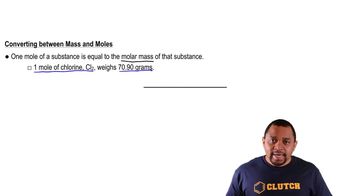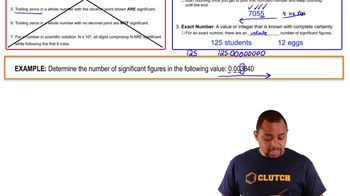The 'lead' in lead pencils is actually almost pure carbon, and the mass of a period mark made by a lead pencil is about 0.0001 g. How many carbon atoms are in the period?
Ch.3 - Mass Relationships in Chemical Reactions
Chapter 3, Problem 57b
What is the mass in grams of each of the following samples? (b) 0.0015 mol of lead
 Verified step by step guidance
Verified step by step guidance1
Identify the molar mass of lead (Pb) from the periodic table, which is approximately 207.2 g/mol.
Use the formula: \( \text{mass} = \text{moles} \times \text{molar mass} \).
Substitute the given number of moles (0.0015 mol) and the molar mass of lead (207.2 g/mol) into the formula.
Calculate the product of 0.0015 mol and 207.2 g/mol to find the mass in grams.
The result from the calculation will give you the mass of the lead sample in grams.

Verified video answer for a similar problem:
This video solution was recommended by our tutors as helpful for the problem above.
Video duration:
1mWas this helpful?
Key Concepts
Here are the essential concepts you must grasp in order to answer the question correctly.
Molar Mass
Molar mass is the mass of one mole of a substance, typically expressed in grams per mole (g/mol). It is calculated by summing the atomic masses of all the atoms in a molecule. For lead (Pb), the molar mass is approximately 207.2 g/mol, which is essential for converting moles to grams.
Recommended video:
Guided course

Molar Mass Concept
Conversion from Moles to Grams
To convert moles of a substance to grams, you multiply the number of moles by the molar mass of the substance. The formula is: mass (g) = moles × molar mass (g/mol). This conversion is fundamental in stoichiometry, allowing chemists to relate quantities of reactants and products in chemical reactions.
Recommended video:
Guided course

Mass and Moles Conversion
Significant Figures
Significant figures are the digits in a number that contribute to its precision. In scientific calculations, it is important to maintain the correct number of significant figures based on the precision of the measurements involved. For example, the value 0.0015 mol has two significant figures, which should be reflected in the final answer when calculating the mass in grams.
Recommended video:
Guided course

Significant Figures Example
Related Practice
Textbook Question
Textbook Question
An average cup of coffee contains about 125 mg of caffeine, C8H10N4O2. How many moles of caffeine are in a cup? How many molecules of caffeine?
Textbook Question
What is the mass in grams of each of the following samples? (a) 0.0015 mol of sodium
Textbook Question
What is the mass in grams of each of the following samples? (c) 0.0015 mol of diazepam (Valium), C16H13ClN2O
Textbook Question
A sample that weighs 25.12 g contains 6.022⨉1023 particles. If 25.00% of the total number of particles are argon atoms and 75.00% are another element, what is the chemical identity of the other constituent?
Textbook Question
A sample that weighs 107.75 g is a mixture of 30% helium atoms and 70% krypton atoms. How many particles are present in the sample?
